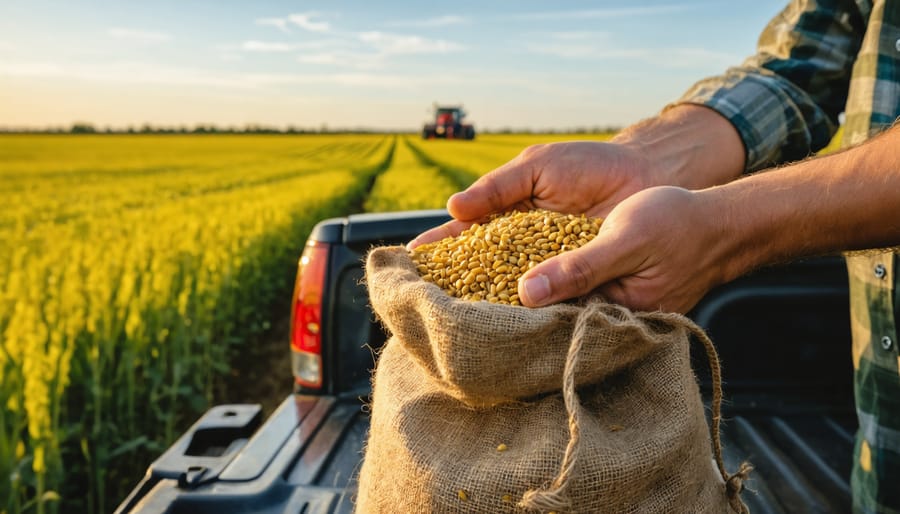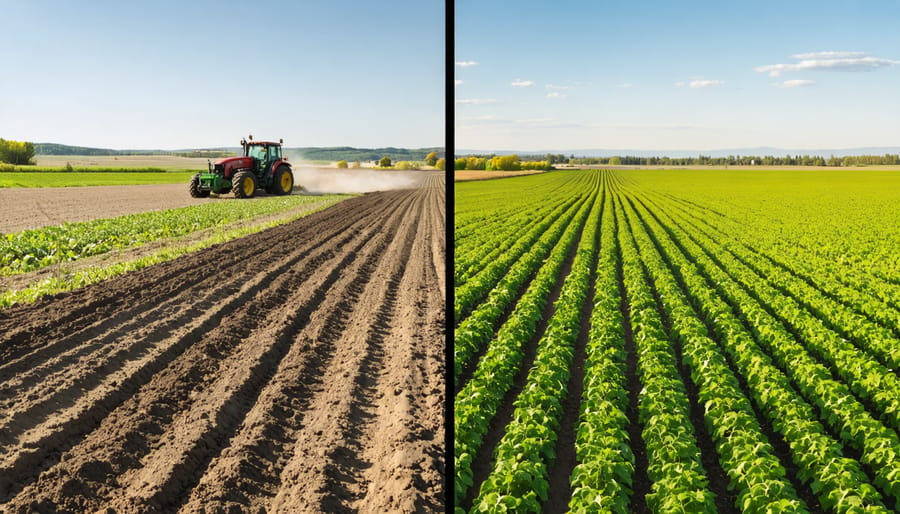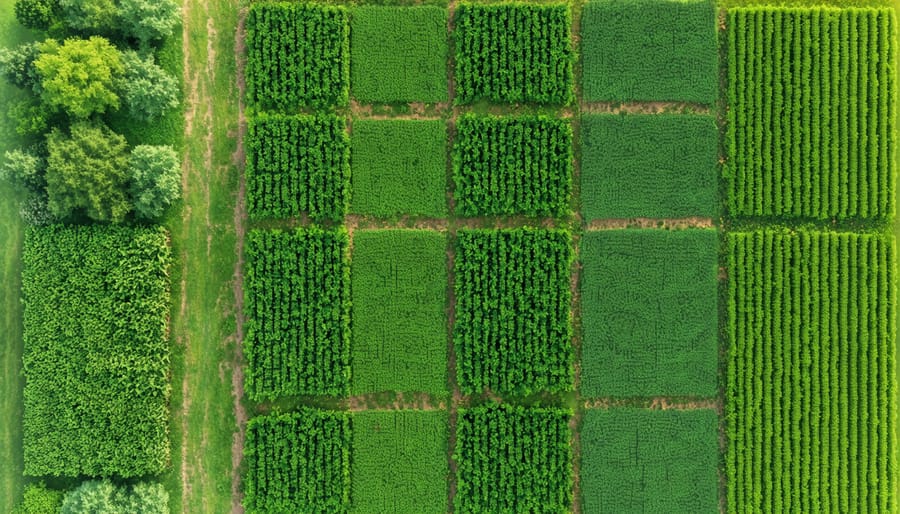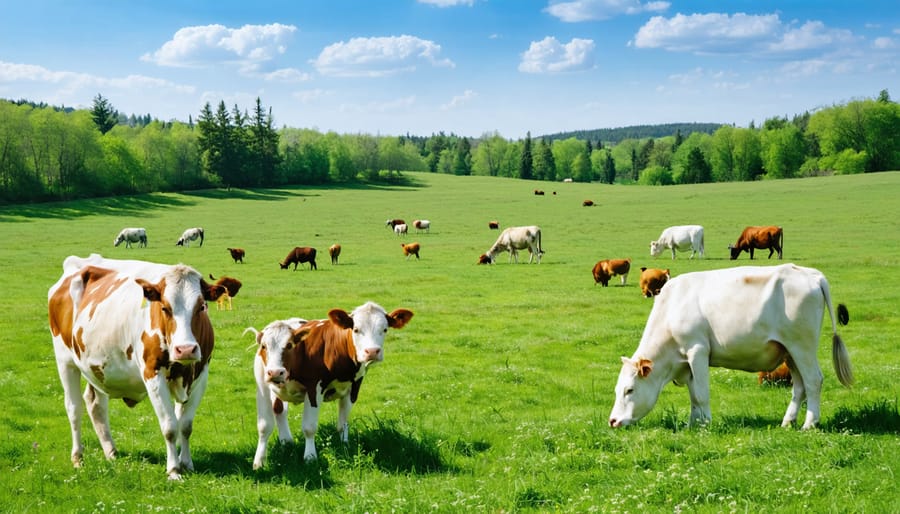Transform your farm into a certified organic operation by mastering Canada’s rigorous organic certification process. Establish detailed farm records documenting three years of chemical-free production methods, including crop rotations, fertility management, and pest control strategies. Implement buffer zones of at least 8 meters between organic fields and conventional farming areas to prevent contamination. Design a soil building program incorporating approved amendments, cover crops, and natural fertilizers that align with Canadian Organic Standards.
Organic farming represents more than a certification—it’s a commitment to sustainable agriculture that benefits soil health, biodiversity, and local ecosystems while meeting growing consumer demand for organic products. Alberta farmers transitioning to organic practices join a thriving community of producers who consistently achieve premium market prices while contributing to environmental stewardship. By understanding and implementing these foundational requirements, producers position themselves for success in Canada’s expanding organic market.
This comprehensive guide breaks down essential organic farming requirements, from initial land preparation through certification maintenance, with specific focus on Alberta’s unique growing conditions and regulatory framework.
Core Requirements for Canadian Organic Certification
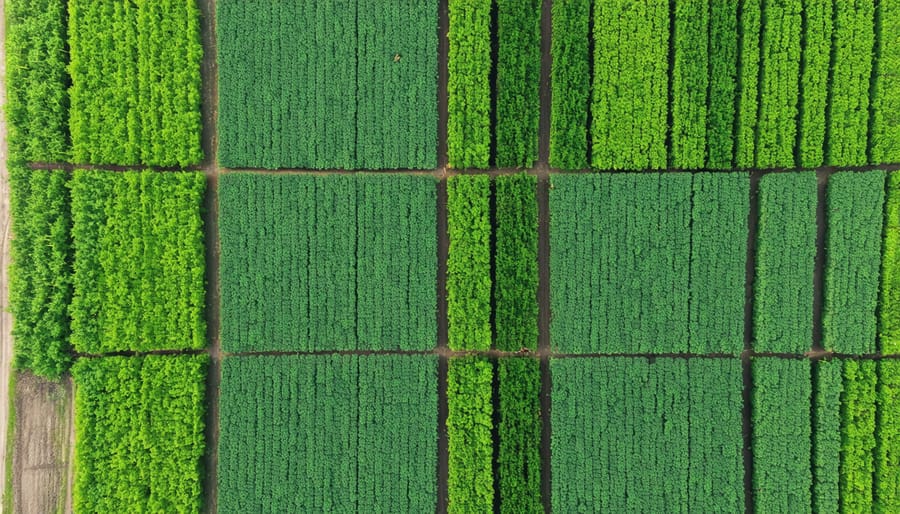
Land and Soil Management Standards
Maintaining healthy soil is the cornerstone of successful organic farming in Alberta. To meet certification requirements, farmers must implement a comprehensive soil management plan that promotes long-term soil fertility without the use of synthetic fertilizers.
Crop rotation is mandatory and must follow a minimum three-year cycle. This practice helps prevent soil depletion, manage pest problems naturally, and maintain optimal nutrient levels. Your rotation plan should include legumes for nitrogen fixation and deep-rooted crops to improve soil structure.
Before achieving organic certification, land must complete a 36-month transition period. During this time, all organic practices must be followed, and no prohibited substances can be applied. Keep detailed records of all field activities, as you’ll need to demonstrate compliance throughout the transition.
Soil testing is required annually to monitor nutrient levels and organic matter content. Based in Alberta’s unique climate conditions, acceptable organic soil amendments include composted manure, green manures, and approved mineral supplements. Buffer zones of at least 8 metres must be maintained between organic and conventional fields to prevent contamination.
Erosion control is crucial in our prairie environment. Implement appropriate measures such as windbreaks, cover crops, and conservation tillage practices. Maintain permanent vegetative cover on steep slopes and along waterways.
Remember to document all soil-building activities, including dates of cover crop planting, cultivation methods, and application of approved amendments. Your record-keeping should clearly demonstrate how your practices build and maintain soil fertility while protecting the land’s natural resources.
To preserve soil moisture in our semi-arid climate, consider mulching and appropriate irrigation scheduling. These practices not only conserve water but also support beneficial soil microorganisms essential for organic production.
Input and Material Guidelines
In organic farming, the careful selection of inputs and materials is crucial for maintaining certification standards. All substances used must comply with the Canadian Organic Standards (COS) and be listed in the Permitted Substances List (PSL). For soil amendments, farmers can use composted animal manure, vermicompost, and green manure crops. However, raw manure must be applied at least 120 days before harvest for crops in direct soil contact.
Approved fertilizers include rock phosphate, potassium sulphate, and mineral elements from natural sources. Farmers often incorporate locally-sourced materials like kelp extracts and bone meal to enhance soil fertility. These materials should be free from synthetic additives and processed using mechanical or biological methods only.
For pest management, organic farmers must prioritize preventive measures through cultural and biological controls. When intervention is necessary, approved organic pest control methods include botanical preparations, diatomaceous earth, and beneficial insects. Many Alberta farmers successfully use companion planting and trap crops as natural pest deterrents.
Seed and planting stock must be organically produced when commercially available. If unavailable, untreated conventional seeds may be used with proper documentation. For livestock operations, feed must be 100% organic, and any supplements or additives must appear on the PSL.
All materials used should be thoroughly documented, including source, application rates, and timing. It’s recommended to maintain relationships with certified organic input suppliers and regularly consult certification bodies about new products or materials before use.

Documentation and Record-Keeping
Required Farm Records
Maintaining detailed farm records is essential for organic certification and demonstrates your commitment to organic practices. As an Alberta farmer, you’ll need to keep comprehensive documentation of all farm activities for at least five years. These records should include seed purchase receipts, showing organic certification status of seeds and any untreated conventional seeds when organic varieties weren’t available.
Track your field activities in a detailed log, including dates of planting, cultivation methods, and harvest times. Document all inputs used, such as compost applications, permitted pest control products, and soil amendments. Keep detailed sales records of organic products, including quantities sold and buyer information.
For livestock operations, maintain records of animal origins, healthcare treatments, feed purchases, and grazing rotations. Buffer zone management and equipment cleaning logs are crucial, especially if you’re managing both organic and conventional fields.
Store these records in an organized system – whether digital or paper-based – making them readily accessible for annual inspections. Many Alberta farmers find success using standardized record-keeping templates available through certification bodies, helping ensure nothing is overlooked during the certification process.
Tracking Systems
Maintaining detailed records is crucial for organic certification and ongoing compliance. Every aspect of your farming operation needs proper documentation, from seed purchases to harvest records. Here in Alberta, successful organic farmers use both digital and paper-based systems to track their operations.
Start by implementing a daily activity log to record all farming practices, including planting dates, crop rotations, and input applications. Keep detailed records of seed sources, ensuring they meet organic standards. Document all purchased inputs, complete with receipts and organic certification verification.
Many Alberta farmers find success using specialized organic farm management software, which helps streamline record-keeping and ensures nothing falls through the cracks. These systems can generate reports for certification inspections and help maintain buffer zone records between organic and conventional fields.
Store all documentation for at least five years, as required by certification bodies. This includes field maps, input records, sales receipts, and cleaning logs for equipment shared between organic and conventional operations. Regular review of your tracking system helps identify areas for improvement and ensures you’re always audit-ready.
Remember, good record-keeping isn’t just about compliance – it’s a valuable tool for improving your farm’s efficiency and productivity while maintaining organic integrity.
The Certification Process in Alberta
Getting certified organic in Alberta follows a structured process that typically takes 12-36 months to complete. The journey begins with a transition period, during which farmers must implement organic practices while maintaining detailed records of their operations.
The first step is selecting a certification body accredited by the Canadian Food Inspection Agency (CFIA). Popular choices in Alberta include Pro-Cert Organic and Ecocert Canada. These organizations will guide you through the certification process and ensure compliance with the Canadian Organic Standards.
Next, farmers must submit an organic system plan detailing their farming practices, including crop rotation schedules, pest management strategies, and soil improvement methods. Documentation of land use history for the previous three years is also required to verify no prohibited substances were applied.
The certification body will then conduct an initial inspection of your farm. This includes reviewing your documentation, examining your fields and facilities, and assessing your record-keeping systems. Understanding the certification costs in Alberta is crucial, as fees vary based on farm size and complexity.
Following a successful inspection, the certification body reviews all findings. If compliant with organic standards, you’ll receive your certification, allowing you to market products as organic. Annual inspections and updates to your organic system plan are required to maintain certification.
Many Alberta farmers find success by connecting with local organic farming associations and experienced organic producers who can provide mentorship throughout the certification process. These relationships often prove invaluable for navigating challenges and sharing best practices.

Annual Inspection and Maintenance
To maintain organic certification, farms must undergo comprehensive annual inspections conducted by approved organic certification bodies. These inspections typically occur during the growing season to verify compliance with organic standards and assess farm operations effectively.
During the inspection, farmers must demonstrate proper record-keeping of all farm activities, including seed purchases, crop rotation plans, input applications, and sales records. Having organized documentation ready for review streamlines the inspection process and shows commitment to organic integrity.
Key maintenance requirements include:
– Updated farm maps showing buffer zones and field rotations
– Complete input records with purchase receipts
– Detailed pest management strategies
– Equipment cleaning logs
– Storage facility maintenance records
– Sales and transaction documentation
Farmers should schedule regular internal audits throughout the year to ensure continuous compliance. Many Alberta producers find success by implementing monthly documentation reviews and maintaining digital records alongside paper copies.
Remember to notify your certifier of any significant changes to your operation, such as new fields, products, or processing activities. Most certification bodies require 60-90 days’ notice before implementing major changes to ensure proper verification and maintain certification status.
Consider joining local organic farmer networks to share experiences and best practices for inspection preparation. These communities often provide valuable insights into efficient record-keeping systems and compliance strategies.
Transitioning to organic farming requires dedication, but the rewards for both your farm and the environment make it a worthwhile journey. By following Canadian organic standards, maintaining detailed records, and implementing sustainable practices, you’re well-positioned to achieve certification. Remember that local certification bodies and experienced organic farmers in Alberta are valuable resources throughout this process. Start by conducting a thorough farm assessment, developing your organic management plan, and connecting with certifying bodies in your region. Consider joining organic farming associations to network with other producers and stay current with industry developments. The path to organic certification may seem complex, but with proper planning and support, your farm can successfully make the transition while contributing to Canada’s growing organic agricultural sector.


